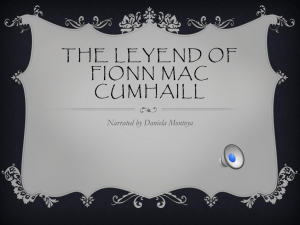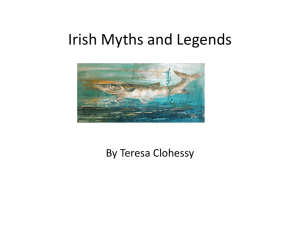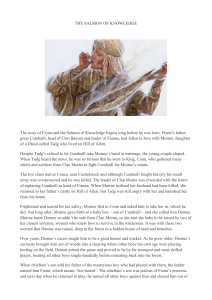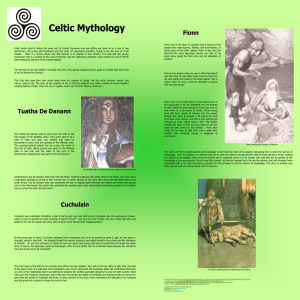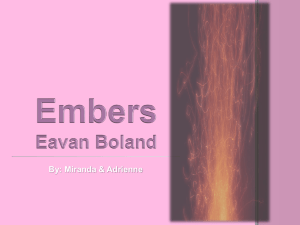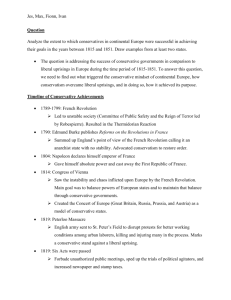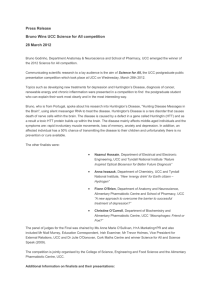Read the transcript of Fionn Mac Cumhaill here
advertisement
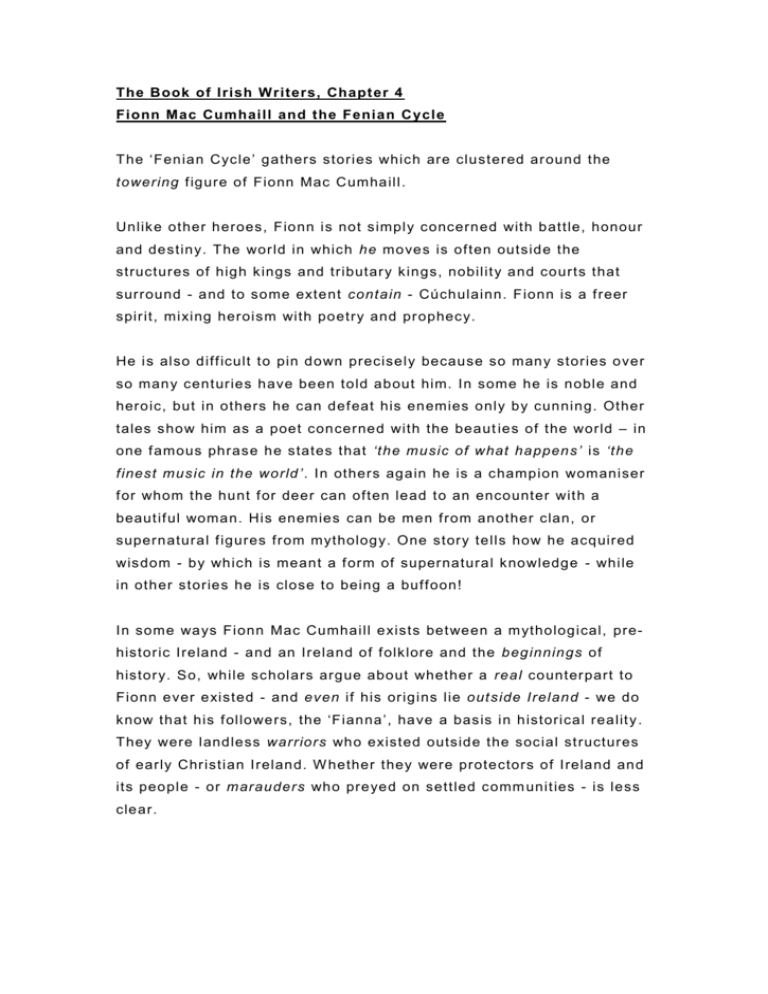
The Book of Irish Writers, Chapt er 4 Fionn Mac Cumhaill and the Fenian Cycle The ‘Fenian Cycle’ gathers stories which are clustered ar ound the towering f igure of Fionn Mac Cumhaill . Unlike other heroes, Fionn is not simply concerned with battle, honour and destiny. The wor ld in which he moves is of ten outside the structures of high kings and tributar y kings, nobilit y and courts that surround - and to some extent contain - Cúchulainn. Fionn is a f reer spir it, mixing heroism with poetry and pr ophecy. He is also diff icult to pin down precisely because so many stories over so many cent uries have been told about him. In some he is noble and heroic, but in others he can def eat his enemies only by cunning. Other tales show him as a poet concerned with the beaut ies of the world – in one f amous phrase he states that ‘the music of what happens’ is ‘the finest music in the world ’. In others again he is a champion womaniser f or whom the hunt f or deer can of ten lead to an encounter wit h a beaut if ul woman. His enemies can be men f rom another clan, or supernatural f igures f rom mythology. One story tells how he acquired wisdom - by which is meant a f orm of supernatural knowledge - while in other stories he is close to being a buf f oon! In some ways Fionn Mac Cumhaill exists bet ween a m ythological, prehistor ic Ireland - and an Ireland of f olklore and the beginnings of histor y. So, while scholars argue about whether a real counter part to Fionn ever existed - and even if his or igins lie outside Ireland - we do know that his f ollowers, the ‘Fianna’, have a basis in historical realit y . They were landless warriors who existed outside the social st ructures of early Chr istian Ireland. W hether they were protectors of Ireland and its people - or marauders who preyed on settled comm unit ies - is less clear. There is no one central stor y - such as the Tain - associat ed with Fionn, but it’s likely that many people will know some version of a Fionn Mac Cumhaill tale. In some stories he is credited with building the Giant’s Causeway, and supposedly creating Lough Neagh and the Isle of Man by r ipping up a clod of earth to throw at a f leeing enem y. Two stor ies show very diff erent sides of Fionn. The stor y of Diarmuid and Gráinne is one of the best -known Fenian tales; in this Fionn is t he jealous old man who, when he cannot have the beautif ul young Gráinne, br ings about the death of her beloved. Another stor y, in a version by the nineteenth -cent ur y writ er W illiam Carleton, was anthologised by W .B. Yeats in his ‘Fair y and Folk Tales of the Irish Peasantry’. In this, Fionn runs home to hide f rom another giant – who is conf usingly called Cucullin, but who is no relation to the Cúchulainn of the ‘Táin Bó Cuailnge’ Fionn is rescued by his wif e’s wit: she dresses him as a baby and convinces his enem y that this massive child is Fionn’s son: “Fin now gave a skir l that star tled the giant, as coming from such a youngster as he was represent ed to be… Cucullin secretly thanked his stars that he had the good fortune to miss meeting Fin ” . This rather knockabout version of Fionn carries over into stories about his son Oisín and his f ollower Caílte - both f eature in stories in which they encounter St Patrick. This meeting allows them to recount tales of the Fianna, Fionn’s warrior f ollowers, and to reg ret the passing of an old Ireland. St Patrick and his new f aith ar e clearly in the ascendant at this time. But Chr ist ianit y still can’t eclipse Fionn - and the oral tradition continues to carr y him along. His f ame has even made him the subject of f raud! James Macpherson was an eighteenth -centur y Scotsman who claimed to have discovered a manuscr ipt cont aining Scots Gaelic ver sions of the Fenian Cycle . He published them in 1773 as ‘The Poems of Ossian’. Despit e being hugely popular and inf luential in the R om antic period - with it s interest in the wild and pr imit ive – it was all a con, a litera r y f raud invented by Macpherson! In contrast to Fionn, Cúchulainn enjoyed neither f ame nor notoriet y in f olklore. W hile later literar y versions of Cúchulainn were res cuing him f rom relative obscurity (he was only really known to scholars of Early Irish literatur e) , Fionn needed no such rescuing ! He had lived on in the mouths of so many storytellers. However, while W .B. Yeats, and others, may have seen the nobilit y and violence of Cúchulainn as an appropr iate symbol f or Ireland, Fionn has one major lit erar y champion . James Joyce much pref erred Fionn’s wiliness and resilience and made him the bedrock of ‘Finnegans W ake’.
